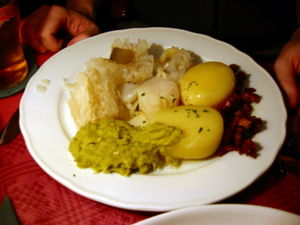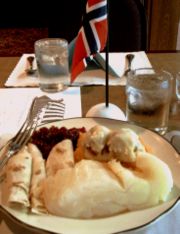
Lutefisk (lutfisk) (pronounced /lʉːtəfɪsk/ in Norway, Minnesota, /lʉːtfɪsk/ in Sweden and the Swedish-speaking areas in Finland) is a traditional food of the Nordic countries made from stockfish (air-dried whitefish) and lye (lut). In Sweden, this food is called lutfisk, omitting the medial 'e'. In Finland the same dish is known as lipeäkala. The direct translation is lye fish, owing to the fact it is made with caustic soda or potash lye.
Contents |
General
Preparation
Lutefisk is made from air-dried whitefish (normally cod, but ling is also used), prepared with lye, in a sequence of particular treatments. The first treatment is to soak the stockfish in cold water for five to six days (changed daily). The saturated stockfish is then soaked in an unchanged solution of cold water and lye for an additional two days. The fish will swell during this soaking, regaining a size even bigger than the original (undried) fish, but the protein content paradoxically decreases by more than 50 percent, causing its famous jelly-like consistency. When this treatment is finished, the fish (saturated with lye) has a pH value of 11–12, and is therefore caustic. To make the fish edible, a final treatment of yet another four to six days (and nights) of soaking in cold water (also changed daily) is needed. Eventually, the lutefisk is ready to be cooked.
In Finland, the traditional reagent used is birch ash. It contains high amount of potassium carbonate and hydrocarbonate, giving the fish more mellow treatment than sodium hydroxide (lyestone). It is important not to incubate the fish too long in the lye, because saponification of the fish fats may occur, effectively rendering the fish fats into soap. The term for such spoiled fish in Finnish is saippuakala (soap fish).
Cooking
After the preparation, the lutefisk is saturated with water and must therefore be cooked carefully so it does not fall into pieces. It does not need any additional water for the cooking; it is enough to place it in a pan, salt it, seal the lid tightly, and let it steam cook under a very low heat for 20–25 minutes. It is also possible to do this in the oven. The fish is then put in an ovenproof dish, covered with aluminium foil, and baked at 225 °C (435 °F) for 40–50 minutes.
When cooking and eating lutefisk, it is important to clean the lutefisk off of pans, plates, and utensils right away. Lutefisk left overnight becomes nearly impossible to remove.
Eating

In the Nordic Countries, the "season" for lutefisk starts early in November and is typically served throughout Christmas. Lutefisk is also very popular in Nordic-American areas of the United States, particularly in the Upper Midwest.
Lutefisk is usually served with a variety of side dishes, including, but not limited to, bacon, green pea stew, potatoes, meatballs, gravy, mashed rutabaga, white sauce, syrup, geitost (goat cheese), or "old" cheese (gammelost). Especially in the U.S., it is usually eaten with lefse. Even if the common denominator is lutefisk, side dishes vary greatly from family to family and region to region, and is a theme of recurring controversy when different "traditions" of lutefisk-eaters meet and eat together.
Nowadays, akvavit and beer often accompany the meal due to its use at festive and ceremonial occasions (and most eaters, regardless of side dish preferences, will argue that these beverages complement the meal perfectly). This is a recent invention however; due to its preservative qualities, lutefisk has traditionally been a common "every day" meal in wintertime.
The dish has sometimes subjected Nordic-Americans to jokes about the personality traits suggested by serving chemically-treated white fish with a white sauce. Lutefisk prepared from cod is somewhat notorious, even within Scandinavia, for its intense odor. Conversely, lutefisk prepared from pollock or haddock has almost no odor. But lutefisk has its fair share of devotees: during 2001 Norwegians alone ate a total of 2,055 tonnes of lutefisk in their homes and approximately 560 tonnes in restaurants.
The taste of well prepared lutefisk is extremely mild and mellow, and often the white sauce is spiced with pepper or other strong tasting spices to bring out the taste.
Origin
Inception
The issue of how lutefisk first was created is as controversial as the fish itself. Some stories tell about fish accidentally dropped in a washing bowl containing lye, and because of poverty the fish had to be eaten nevertheless. Yet other stories tell about fires of various kinds, because ashes of wood combined with water will create lye. A possible scenario is that drying racks for stockfish caught fire, followed by days of rain, and again, because of poverty, the fish still had to be picked from the ashes, cleaned, prepared and eaten. It is quite possible the softening with lye, which is actually a fairly common practice with many kinds of food, was deliberate rather than accidental.
Traces in literature
When people first started eating lutefisk is controversial. Some enthusiasts claim the tradition goes back to the age of Vikings, other and contrasting views claim that the meal has 16th century Dutch origins. Despite this, it is somewhat commonly agreed that the first written mention of the phenomenon "lutefisk" traces back to a letter from Swedish king Gustav I in 1540, and the first written description of the preparation process is in Swedish archbishop Olaus Magnus's (1490–1557) personal writings from 1555. When it comes to Norwegian traces, author Henry Notaker (in the encyclopedia "Apetittleksikon") claims that the first written traces in Norway dates to the south-eastern parts of Norway in the late 18th century. Additionally, a classic Norwegian cookbook ("Hanna Winsnes") from 1845 tells about how to make lye for lutefisk from a combination of birch ash, limestone, and water.
A folk tale about the origin of lutefisk says when the Vikings were pillaging Ireland, St. Patrick sent men to pour lye on the store of dried fish on the longships with the hope of poisoning the Vikings and thereby ridding Ireland of these intruders. However, rather than dying of poisoning or starvation, the Vikings declared lutefisk a delicacy. Some Scandinavian descendants claim their strength and longevity are derived from eating lutefisk at least once a year.
Misconception of Norwegians and lutefisk
A misconception originating in the United States is that most Norwegians eat and enjoy lutefisk. In real life lutefisk is more common in the Norwegian-American community than it is among actual modern day Norwegians. For example both Glenwood, Minnesota and Madison, Minnesota claim to be the "lutefisk capital of the world." A survey[1] performed by the National Information Office for Meat in Norway claimed that as few as only 2 percent of Norwegians have lutefisk on Christmas Eve (compared to 52 percent who eat rib roast, the most popular Christmas dinner in Norway), while 20 percent eat lutefisk before Christmas.
Lutefisk humor
Lutefisk eaters thrive on quotes and jokes from skeptics of lutefisk comparing it to everything from rat poison (which has a hint of truth to it, because of the traces of unnatural amino acid lysinoalanine found in lutefisk due to the reaction with lye) to weapons of mass destruction. A few examples are:
- Quote from Garrison Keillor's book Lake Wobegon Days:
"Every Advent we entered the purgatory of lutefisk, a repulsive gelatinous fishlike dish that tasted of soap and gave off an odor that would gag a goat. We did this in honor of Norwegian ancestors, much as if survivors of a famine might celebrate their deliverance by feasting on elm bark. I always felt the cold creeps as Advent approached, knowing that this dread delicacy would be put before me and I’d be told, "Just have a little." Eating a little was like vomiting a little, just as bad as a lot."
- Interview with Jeffrey Steingarten, author of The Man Who Ate Everything (translated quote from a 1999 article in Norwegian newspaper Dagbladet:)
"Lutefisk is not food, it is a weapon of mass destruction. It is currently the only exception for the man who ate everything. Otherwise, I am fairly liberal, I gladly eat worms and insects, but I draw the line on lutefisk."
"What is special with lutefisk?"
"Lutefisk is the Norwegians' attempt at conquering the world. When they discovered that Viking raids didn't give world supremacy, they invented a meal so terrifying, so cruel, that they could scare people to become one's subordinates. And if I'm not terribly wrong, you will be able to do it as well."
"But some people say that they like lutefisk. Do you think they tell the truth?"
"I do not know. Of all food, lutefisk is the only one that I don't take any stand on. I simply cannot decide whether it is nice or disgusting, if the taste is interesting or commonplace. The only thing I know, is that I like bacon, mustard and lefse. Lutefisk is an example of food that almost doesn't taste anything, but is so full of emotions that the taste buds get knocked out."
Other
The rocks studied by rovers on the planet Mars are often given funny names. One that the Spirit rover examined for several days was called Lutefisk.
In the popular video game Psychonauts, one of the characters is named Nils Lutefisk, Nils being a common Norwegian name.
In the episode of King of the Hill titled "Revenge Of The Lutefisk," the new reverend at the Hills' church, a native of Minnesota, brings a dish of lutefisk to a church potluck. Though the other guests are wary of, even repulsed by the lutefisk, Bobby Hill tastes it and finds it so irresistible that he takes the whole dish of lutefisk with him under the buffet table and eats it all. After it works its way through him in the church bathroom the next day, he uses a match to cover the smell and accidentally lights the church on fire.
The 1999 film Drop Dead Gorgeous, set in the Midwest, makes a reference to lutefisk. One character mentions it's best with "lots of butter."
An open-source de novo sequencing package for mass spectrometry data.[1]
Spellings
- Norwegian: lutefisk (earlier ludefisk (Danish) spelling still sometimes used in English)
- Swedish: lutfisk
- Finnish: lipeäkala
References and external links
- The History Of Lutfisk
- Lutefisk for Christmas
- Clay Shirky on eating lutefisk
- Chemistry of Lutefisk (in Swedish)
Notes
- ^ Lutefisk software accessed 2006-08-08
Categories: Christmas food
